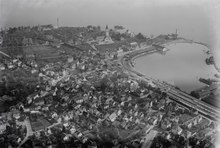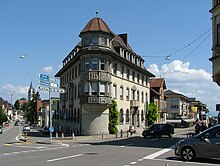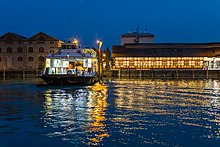Romanshorn
| Romanshorn | |
|---|---|
| State : |
|
| Canton : |
|
| District : | Arbon |
| BFS no. : | 4436 |
| Postal code : | 8590 |
| UN / LOCODE : | CH RMH |
| Coordinates : | 746 331 / 270 253 |
| Height : | 406 m above sea level M. |
| Height range : | 395–449 m above sea level M. |
| Area : | 8.73 km² |
| Residents: | 11,165 (December 31, 2018) |
| Population density : | 1279 inhabitants per km² |
| Website: | www.romanshorn.ch |
|
Romanshorn |
|
| Location of the municipality | |
Romanshorn , in the Swiss German local dialect Romishorn [ˈromisˌhɔrn] , is a political municipality and a locality in the district of Arbon in the canton of Thurgau , Switzerland .
geography
The urbanized village is located on the southern shore of Lake Constance and borders the communities of Uttwil , Hefenhofen and Salmsach .
Romanshorn has a hinterland with a large forest that has received the national Binding Prize for exemplary forest management .
climate
The annual mean temperature is 9.3 ° C, with the coldest monthly temperatures in January at 0.4 ° C and the warmest monthly mean temperatures in July at 18.7 ° C. On average, around 83 frost days and 22 ice days are to be expected here. There are around 41 summer days on average, while there are an average of 5.6 hot days . The MeteoSwiss weather station is at an altitude of 440 m above sea level. M. in the town Güttingen , 7 kilometers northwest of Romanshorn ( straight line ).
| Romanshorn (Güttingen weather station), 1981–2010 | ||||||||||||||||||||||||||||||||||||||||||||||||
|---|---|---|---|---|---|---|---|---|---|---|---|---|---|---|---|---|---|---|---|---|---|---|---|---|---|---|---|---|---|---|---|---|---|---|---|---|---|---|---|---|---|---|---|---|---|---|---|---|
| Climate diagram | ||||||||||||||||||||||||||||||||||||||||||||||||
| ||||||||||||||||||||||||||||||||||||||||||||||||
|
Average monthly temperatures and precipitation for Romanshorn (Güttingen weather station), 1981–2010
Source:
|
||||||||||||||||||||||||||||||||||||||||||||||||||||||||||||||||||||||||||||||||||||||||||||||||||||||||||||||||||||||||||||||||||||||||||||||||||||||||||||||||||||||||||||||||||||
history
Romanshorn was populated by novels until the end of the 7th century . Rumanishorn was first mentioned in the year 779 or 782, when Waldrata gave her property in Romanshorn to the St. Gallen monastery . In the late Middle Ages until 1367, the Vogtei Romanshorn was temporarily owned by von Landenberg . In 1455 Abbot Kaspar von Landenberg sold the land of the city of St. Gallen , but the people of the church forced the sale to be judicially canceled. The court Romanshorn received in 1469 by Abbot Ulrich Roesch an opening and was the Romanshorner Office managed. Until 1798, the St. Gallen monastery held team rights, appellation and tribute - mostly in Täschlishusen near Häggenschwil . The other sovereign rights belonged to the Landgraviate of Thurgau . In 1803 the local and municipal parishes of Romanshorn were formed, which united in 1870 to form the unified municipality of Romanshorn.
In 779 a church was mentioned in Romanshorn. The people priest attested in 1275 had a benefice of 16 pounds. In 1480 St. Gallen incorporated the church, which was enlarged in 1504. In 1525 Romanshorn joined the Reformation as a whole. In 1588, the federal umbrella locations determined that the Reformed Salmsach pastor should also provide Romanshorn. Romanshorn remained a branch until the Romanshorn-Salmsach parish was formed . In 1567 the abbot installed a Catholic priest . In 1586 the Catholics received the rectory and the beneficiaries. The number of Catholics increased through further favors. In 1588 Romanshorn had two Catholic families, in 1711 36 of them. In 1829 the church was renovated. The Reformed received a new house of worship in 1911 and the Catholics in 1913, which dissolved simultaneity .


Grain, horticulture and fruit growing dominated the economy. In addition to forestry and fishing, there was also some viticulture until 1902. The steamboats that operated from 1824 docked in Romanshorn from 1832 instead of in Uttwil as before . Only when the canton of Thurgau built a port from 1840 to 1844 and the postal routes to Swabia via Romanshorn did Romanshorn begin to grow. The Zurich – Romanshorn railway line was opened in 1855 and a telegraph cable was laid through the lake in 1856 . The ferry traffic from Lindau to Romanshorn was recorded in 1869, 1945 ferries expanded and set 1976th In 1869 and 1871, respectively, the Nordostbahn took the Rorschach – Romanshorn – Konstanz line into operation. In 1910 the Bodensee-Toggenburg Railway to St. Gallen was opened. The favorable location attracted trade and industry after 1850. The Fatzer company, founded in 1836, initially produced cords and ropes. In 1895 she switched to wire rope production. In 1985 the company with 85 employees processed, among other things, 2000 tons of steel wire. From the pharmacy of Max Zeller, who sold the famous cell balm from 1864, the company Max Zeller Söhne AG developed. In 2008, the pharmaceutical company employed almost 100 people. The warehouse of the Federal Alcohol Administration opened in 1892 had a capacity of 30 million liters of alcohol by 1980. In 1904 the Voigt company was founded in Romanshorn, which in 2008 employed around 250 people and supplies pharmaceutical products to companies operating around the world. Other well-known companies include Biro (plastics), the Hydrel machine factory (including hydraulics, pneumatics) and Asco Kohlensäure AG. The canton school Romanshorn started operations in 1969. In 1970, the Thurgauisches Sprachheilheim association founded by cantonal women's associations, and since 1976 Thurgau Sprachheilschule, opened a house. Romanshorn developed into a residential community after 1945, but there were around 5300 jobs in the village in 2005, 58% of them in the third economic sector .
Until 2002 Romanshorn was a unified municipality .
coat of arms
Blazon : In yellow a slanted black horn.
The coat of arms appears for the first time in 1551 and 1581 on official discs of the Abbot of St. Gallen.
population
 |
| year | 1831 | 1850 | 1900 | 1950 | 1980 | 1980 | 1990 | 2000 | 2010 | 2018 |
| Residents | 1218 | 1408 | 4577 | 6648 | 7893 | 7893 | 8899 | 9076 | 9699 | 11,114 |
Of the total of 11,114 inhabitants of the Romanshorn municipality in 2018, 3,429 or 30.9% were foreign nationals.
economy

Romanshorn was once a fishing village and with the construction of the harbor and the railway line it has become a trading and tourist center. Today Romanshorn is a modern industrial location with broad diversification: plastic products, machine industry, chemicals, pharmaceuticals etc. In around 600 companies 5000 jobs are offered. The service sector and the educational offer, for example with the cantonal school, are also of great importance. The importance of federal companies (SBB including shipping companies, then PTT and ZD) as an employer has declined significantly over the last few decades. In 2016 Romanshorn offered work for 4,352 people (converted to full-time positions). 0.9% of these were employed in agriculture and forestry, 43.4% in industry, trade and construction and 55.7% in the service sector.
The Max Zeller Söhne AG company has existed for more than 140 years and produces herbal remedies (so-called phytopreparations) with around 90 employees.
politics
In the 2019 National Council elections, the proportion of voters in Romanshorn was: SVP 29.8%, SP 20.5%, FDP 12.1%, CVP 11.7%, Greens 10.3%, glp 7.7%, EPP 3.4 %, EDU 3.2%, BDP 1.4%.
traffic
The place is favored by its traffic situation. Romanshorn has the largest port on Lake Constance in terms of water area. A car ferry connects Romanshorn with Friedrichshafen . Trains run from Romanshorn railway station in four directions: on the lake line to Rorschach and Kreuzlingen , and also to Zurich (express train line to Brig-Glis ) and St. Gallen .
Attractions
The urbanized village of Romanshorn is listed in the inventory of places worth protecting in Switzerland . The three churches are among the most important and distinctive sights:
- the old church with parity (10th - 16th century)
- and the Reformed Church (1911, Heimatstil)
- the Catholic Church of St. John the Baptist (1913, Neo-Roman / Byzantine). The choir and nave were painted by Fritz Kunz .
On the south side of the harbor front are the mighty former warehouses and on the north side the old customs house (now a museum).
Autobau , a private collection of sports and racing cars , has been located in the former tank farm of the former alcohol administration since 2009 .
education
The multiple educational opportunities on site are particularly important. At public schools, Romanshorn offers a primary and secondary school as well as a canton school . There is also the Romanshorn Curative Education Center, the Romanshorn Music School and the Thurgau Language School. The SBW private school with the “House of Learning” and the “SBW Neue Medien AG” are also located in Romanshorn, the latter offering training as a media specialist. Thanks to its easy accessibility, Romanshorn is a central school location in Oberthurgau. The many educational opportunities on site are of particular importance, but also the wide range of leisure facilities on water and on land. A modern ice rink is just as much a part of the sporting offer as a popular seaside resort. Romanshorn is also a starting point for hikers, skaters and bikers.
Festivals
The “Nations Festival” was created in 1999 during the parish council weekend of the Catholic parish of St. John. The group of foreigners, which should take care of the concerns of all nations in Romanshorn, as well as the Gruppo Culturale , which works for the preservation of the Italian values and the connection to the Swiss values, were founded. The "Nations Festival" takes place every year in June. The aim of the event is: «In a cozy atmosphere, the exchange between people from different nations is to be promoted. The national representatives offer culinary specialties from their countries and an attractive stage program ».
Personalities
- Lucie Bänziger-Bardy (1877–1958), committed entrepreneur in the non-profit women's association
- Guido Baumann (1926–1992), journalist and television man
- Jytte Borberg (1917-2007), Danish writer
- Carl Brüschweiler (1878–1956), statistician
- Ludwig Demarmels (1917–1992), skier and painter
- Peter Dschulnigg (1943–2011), Roman Catholic theologian
- Johannes Gees (* 1960), artist and media producer
- Claudius Graf-Schelling (1950–2019), politician (SP)
- Martina Hälg-Stamm (1914–2011), SP politician and first member of the Thurgau Cantonal Council
- Paul Ilg (1875–1957), writer
- Kurt Imhof (1956–2015), sociologist and journalist
- Erwin Kessler (* 1944), civil engineer and animal rights activist
- Henri König (1896–1983), sculptor
- Paul Kuhn (1920–2002), gardener and founder of the St. Michaelsvereinigung
- Dora Labhart-Roeder (1897–1992), first Thurgau attorney with her own law firm, founder of the Thurgau non-profit women's association
- Paul Lascaux, actually Paul Ott (* 1955), writer
- Antonio Ligabue (1899–1965), painter
- Daniel Lopar (* 1985), professional footballer
- Peter Lüscher (* 1956), former ski racer
- Rose-Marie Maron (* 1935), painter. Collage, tapestry and printmaking
- Doris Quarella (1944–1998), photographer
- Florian Rexer (* 1976), actor, director and director of the Hagenwil Castle Festival on Lake Constance
- Vreni Schawalder (* 1946), SP politician and first member of the Thurgau government
- Jürg Schoop (* 1934), painter, musician, man of letters, filmmaker, photographer and mediator
- Maria Stader (1911–1999), origin. Maria Molnár, lyric soprano
- Christoph Sutter (* 1962), teacher, copywriter, poet, ghostwriter, moderator, musical and theater author
- Max Zeller-Fehr (1881–1954), pharmacist, entrepreneur
- Max Zeller (1913–1961), origin. Max Eduard Zeller, entrepreneur
Web links
Individual evidence
- ↑ Permanent and non-permanent resident population by year, canton, district, municipality, population type and gender (permanent resident population). In: bfs. admin.ch . Federal Statistical Office (FSO), August 31, 2019, accessed on December 22, 2019 .
- ↑ a b Thurgau in figures 2019 . On the website of the Statistical Office of the Canton of Thurgau (PDF file; 1.8 MB), accessed on April 28, 2020.
- ↑ Lexicon of Swiss Community Names , ed. from the Center de Dialectologie at the University of Neuchâtel under the direction of Andres Kristol, Frauenfeld / Lausanne 2005, p. 753.
- ↑ a b Localities and their resident population. Edition 2019 . On the website of the Statistical Office of the Canton of Thurgau (Excel table; 0.1 MB), accessed on April 28, 2020.
- ↑ Climate table. In: meteoschweiz.admin.ch. meteoschweiz, accessed on July 6, 2020 .
- ↑ StiASG , Urk. I 69. Online at e-chartae , accessed on June 25, 2020.
-
↑ a b c d Erich Trösch: Romanshorn. In: Historical Lexicon of Switzerland .
These sections are largely based on the entry in the Historical Lexicon of Switzerland (HLS), which, according to the HLS's usage information, is under the Creative Commons license - Attribution - Share under the same conditions 4.0 International (CC BY-SA 4.0). - ↑ a b c municipal coat of arms . On the website of the State Archives of the Canton of Thurgau, accessed on December 8, 2019
- ↑ a b Population development of the municipalities. Canton Thurgau, 1850–2000 and resident population of the municipalities and change from the previous year. Canton of Thurgau, 1990–2018. On the website of the Statistical Office of the Canton of Thurgau (Excel tables; 0.1 MB each), accessed on April 28, 2020.
- ^ Federal Statistical Office : NR - Results parties (municipalities) (INT1). In: Federal Elections 2019 | opendata.swiss. August 8, 2019, accessed August 1, 2020 .
- ^ Website of the canton school Romanshorn
- ^ Website for the festival of nations
- ↑ Festival and History












